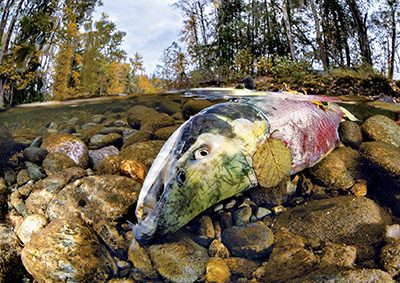IN THE ADAMS RIVER IN BRITISH COLUMBIA, huge flows of sockeye salmon swim upstream to complete their life cycle, marked by the compelling need to return to their birthplace to spawn. Their unique journey from the ocean to their freshwater birthplace to reproduce is riddled with obstacles and dangers.
A drought in 2022 added another threat to their chances of survival. The unseasonably warm autumn weather in British Columbia caused an unexpectedly low level of water that forced me to dig into the riverbed in some places to create enough space to dip the camera housing. Luckily, the water in the Adams River and its minor tributaries is so clear that digging into the bed did not create clouds of suspended particles.
The bodies of sockeye salmon become red and green only during the spawning season. Sockeye salmon also have an evident sexual dimorphism. The males develop the iconic hooked and elongated jaws, larger dorsal humps, longer teeth, and heavier skin.
Male aggression reflects competition for access to reproductively active females. Salmon engage in combat, attacking other salmon by biting them on the body or caudal peduncle or jousting with jaws. Larger teeth presumably confer an advantage during these attacks, and skin thickness may have evolved as protection. AD

Equipment: Sony a7R IV, Canon EF 8-15mm f/4 lens at 15mm, Isotta housing, two Isotta Red64 strobes
Settings: 1/60 sec, f/22, ISO 1250 (inset: ISO 640)
Location: Adams River, British Columbia, Canada
© Alert Diver — Q4 2023